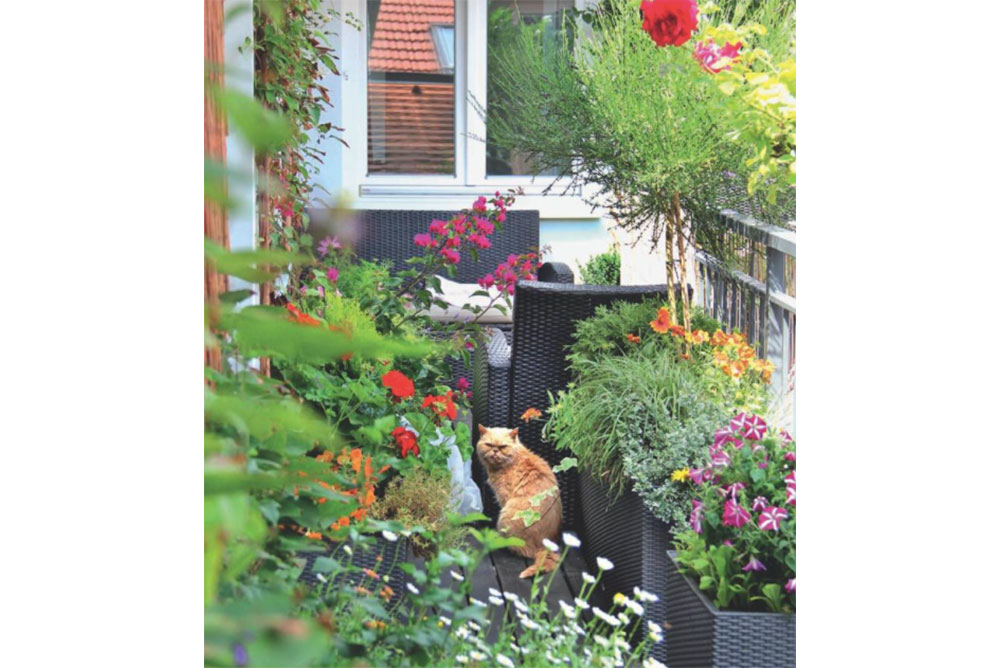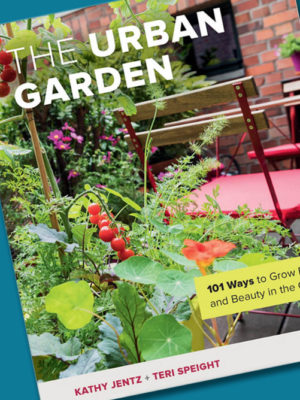
Image from “The Urban Garden: 101 Ways to Grow Food and Beauty in the City.” / Image from the book.
By Stephanie Cavanaugh
THERE ARE things peculiar to city gardens and peculiar things about city gardens.
Unlike the suburbs, city gardens don’t, as a rule, have marauding deer—though the occasional one makes an appearance, causing general delight, at least in my neck of the woods. Neighbors hang over railings, cameras capture the strange sighting, which usually makes the evening news. It’s as if we’d spotted a minotaur or an elephant.
Well, we used to have an annual parade of elephants when the circus would come to town, stomping up the excitement, as it were, but that’s neither here nor there, as the circus is kaput.
 However, there are animals about. Mostly squirrels, which are generally considered cute, and the occasional opossum. We had one of those for a spell. She used to perch on the fence of an evening, weird reflective eyes quietly watching us dine on the back porch. There are also raccoons, cursed for plucking expensive koi from backyard ponds. This week there was a fox trotting around the US Capitol grounds, and what a foofaraw he (or she) caused, nipping at lawmakers’ ankles as we often wish we could.
However, there are animals about. Mostly squirrels, which are generally considered cute, and the occasional opossum. We had one of those for a spell. She used to perch on the fence of an evening, weird reflective eyes quietly watching us dine on the back porch. There are also raccoons, cursed for plucking expensive koi from backyard ponds. This week there was a fox trotting around the US Capitol grounds, and what a foofaraw he (or she) caused, nipping at lawmakers’ ankles as we often wish we could.

Kathy Jentz, left, and Teri Speight, authors of The Urban Garden: 101 Ways to Grow Food and Beauty in the City. / Jentz photo by Zoe Zindash, Speight photo by Kizi N’Kodia.
But it is mainly dogs that are a nuisance in the city, destroying curbside gardens with their digging and acid-rain-quality pee, and any patch of grass neighbors have the audacity to try to maintain.
Close behind this menace are plant thieves of the two-legged variety, snatching tomatoes and peonies that dare come close enough to the garden’s edge to get pinched, and postal workers, ears glued to phones, that tromp their way through the tulips.

The urban garden of our dreams, from “The Urban Garden: 101 Ways to Grow Food and Beauty in the City.” / Photo by Kathy Jentz.
We, meaning our gardens, again in general, are small. Too small for big trees—though some, like me, plant them anyway, figuring (wrongly) that we’d have long moved to Key West before their size became an issue.
And with homes butted up against one another, with low fences if any, there’s not one hell of a lot of privacy.
Scale, privacy, foiling miscreants, plant selection, and making a lot out of a little are the essential themes of The Urban Garden: 101 Ways to Grow Food and Beauty in the City, by Kathy Jentz, editor and publisher of Washington Gardener Magazine, and Teri Speight, garden speaker, writer, podcaster, and former head gardener for the City of Fredericksburg, Virginia. Together they consider the pitfalls and pleasures of city gardening. A tiny garden can be freeing, they say. If there’s only so much you can do in a small space, focus on creating a “jewel box,” they say.
It’s a slim book, just over 300 pages, but comprehensive; though there are numerous how-tos, it’s more of an engagingly written idea springboard than an instruction manual. While an experienced gardener could run with the ideas, someone new to gardening would find the book most useful as inspiration.
The authors stumble with ideas for entertaining and garden art— “Give Barbie and her friends an outdoor jungle-themed disco.” Good God, no! But when the focus is on gardens, they’re firmly rooted in their element.
There are excellent chapters on creating cottage gardens, night gardens, perennial gardens, water features, scented gardens, roof gardens, and Asian gardens. Other chapters focus on ground covers, shrubs, and small trees for year-round interest; using pots and window boxes for herbs and vegetables as well as flowers; vertical gardening; lighting; creating privacy with plants and ornaments; laying out the garden to make it seem larger; and hardscaping—how and where to lay out paths, and the wealth of unusual materials you might use, such as moss and creeping herbs instead of stone or brick in lightly trod areas.
Offbeat ideas are liberally sprinkled. Like growing rice in a pot with no drainage: It unfurls like tall grasses, and yes, you can harvest it for dinner. Or growing “franken-trees,” dwarf fruit trees with several varieties of fruit grafted onto a single plant. Say, an apple tree with one branch of Fuji and another of Honeycrisp, or “fruit cocktail” trees grafted with varieties of plums and peaches.
Hiding or distracting from eyesores such as power lines and trash bins gets several chapters on materials for screening the unsightly, or just distracting the eye. Like hanging an actual door or picture frame to highlight an artful patch of garden, or using mirrors, which also open-up tight spaces and reflect often sparse light.
And yes, there are suggestions for dealing with dogs and plant thieves, from planting thorny plants along garden borders to foil tomato thieves to inserting twigs among the shrubbish to discourage dogs from squatting among the peonies. Though I have found fondue forks work best, those pronged ends really get the point across. And I haven’t made fondue in a few decades anyway.
MyLittleBird often includes links to products we write about. Our editorial choices are made independently; nonetheless, a purchase made through such a link can sometimes result in MyLittleBird receiving a commission on the sale, whether through a retailer, an online store or Amazon.com.
